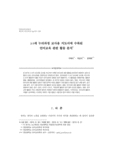

PARTNER
검증된 파트너 제휴사 자료
3-5세 누리과정 교사용 지도서에 수록된 언어교육 관련 활동 분석
방대한 850만건의 자료 중 주제별로 만들수 있는 최적의 산출물을 해피 캠퍼스에서 체험 하세요 전문가의 지식과 인사이트를 활용하여 쉽고 폭넓게 이해하고 적용할수 있는 기회를 놓치지 마세요
24 페이지
최초등록일 2015.03.25
최종저작일
2013.08

-
 * 본 문서는 배포용으로 복사 및 편집이 불가합니다.
* 본 문서는 배포용으로 복사 및 편집이 불가합니다.
미리보기
서지정보
· 발행기관 : 한국어린이미디어학회
· 수록지 정보 : 어린이미디어연구 / 12권 / 2호
· 저자명 : 구태미, 유순이, 윤재희
목차
Ⅰ. 서 론
Ⅱ. 연구 방법
Ⅲ. 연구 결과
Ⅳ. 논의 및 제언
초록
본 연구는 3-5세 누리과정 교사용 지도서에 수록된 언어교육 관련 활동을 분석하여 현장에서 실제 진
행되고 있는 언어교육을 간접적으로 파악하고자 한다. 분석대상은 3-5세 누리과정 교사용 지도서의
2,175개 활동에서 활동 목표가 언어교육과 관련된 562개 활동이다. 이 활동들을 내용범주별, 활동유
형별, 통합영역별, 교수매체별로 분석했다. 본 연구의 결과는 다음과 같다. 첫째, 지도서에 수록된
언어교육 관련 활동은 말하기 내용 범주에 속하는 활동이 가장 많았고 다음으로 듣기 내용 범주, 읽기
내용 범주, 쓰기 내용 범주에 속한 활동의 순으로 많았다. 둘째, 언어교육 관련 활동의 유형은 모든
연령에서 동화․동시․동극, 이야기 나누기, 자유선택 활동의 언어 영역 순으로 많았다. 셋째, 언어
교육 활동은 주로 사회관계 영역과 자연탐구 영역과 통합되어 있었다. 마지막으로, 언어교육 활동에
사용된 교수매체는 시각적인 매체가 가장 많았고 시청각과 청각 매체가 뒤를 이었다.영어초록
The purpose of the study is to examine the practice of language education for young children by
analyzing activities related to language education contained in the Teacher’s Guidebook of the Nuri
curriculum for children aged three to five. Among 2,175 activities of Teacher’s Guidebook Nuri
curriculum for children at age three to five, 562 activities with objectives related to language
education are the subject of analysis. The language activities were classified for each content category,
activity type, integrated category and teaching media. The results are followings. First, the activities
within the speaking category were the most for language activities, followed by listening
comprehension, reading, and writing activities. Second, type of language activities listed on the
instruction was shown for all ages in the sequence of story tale, children’s poetry, drama,
story-telling, and language territory. Third, the language activities were mainly integrated with social
relationship territory and nature search territory. Lastly, visual media was the frequently used
teaching media used in the language activities, followed by visual &audio and audio media.참고자료
· 없음태그
-
자료후기
-
자주묻는질문의 답변을 확인해 주세요

꼭 알아주세요
-
본 학술논문은 (주)학지사와 각 학회간에 저작권계약이 체결된 것으로 AgentSoft가 제공 하고 있습니다.
본 저작물을 불법적으로 이용시는 법적인 제재가 가해질 수 있습니다. -
해피캠퍼스는 구매자와 판매자 모두가 만족하는 서비스가 되도록 노력하고 있으며, 아래의 4가지 자료환불 조건을 꼭 확인해주시기 바랍니다.
파일오류 중복자료 저작권 없음 설명과 실제 내용 불일치 파일의 다운로드가 제대로 되지 않거나 파일형식에 맞는 프로그램으로 정상 작동하지 않는 경우 다른 자료와 70% 이상 내용이 일치하는 경우 (중복임을 확인할 수 있는 근거 필요함) 인터넷의 다른 사이트, 연구기관, 학교, 서적 등의 자료를 도용한 경우 자료의 설명과 실제 자료의 내용이 일치하지 않는 경우
“어린이미디어연구”의 다른 논문도 확인해 보세요!
-
유아의 놀이계획-실행-평가 활동이 창의적 성향의 놀이와 행동적 자기조절력에 미치는 영향 18 페이지
본 연구는 놀이계획-실행-평가 활동이 유아의 창의적 성향의 놀이행동과 행동적 자기조절력에 미치는 영향을 알아보고자 하였다. 연구의 대상은 만 5세 유아 33명이고, 실험집단 유아 20명을 대상으로 8주 간에 걸쳐 ‘놀이계획-실행-평가’활동을 실시한 후 그 효과를 검증하고자 하였다. 이를 위해 공변량 분 석을 실시하였다. 연구결과는 첫째, 창의적 성향의.. -
사진을 활용한 숲 체험 활동이 유아의 환경 감수성 및 환경 친화적 태도에 미치는 영향 24 페이지
본 연구의 목적은 사진을 활용한 숲 체험 활동이 유아의 환경 감수성 및 환경 친화적 태도에 미치는 영향을 알아보기 위한 것이다. 이를 위해 강원도 K시에 위치한 두 유치원의 만 4세 두 학급을 선정한 뒤, 실험집단 유아 17명에게 14주 동안 사진을 활용한 숲 체험 활동을 실시하였다. 본 연구결과, 사진 을 활용한 숲 체험 활동을 경험한 실험집단 유아.. -
ARCS동기전략을 활용한 통합적 미술 활동이 유아의 그리기표상능력에 미치는 영향 21 페이지
본 연구의 목적은 ARCS동기전략을 활용한 통합적 미술 활동이 유아의 그리기표상능력에 어떠한 영향 을 미치는지를 알아보기 위한 것이다. 연구 대상은 사회․경제적 배경이 비슷한 2개 유치원에 재원중 인 만5세 유아 30명(실험집단 15명, 비교집단 15명)이었다. 실험집단은 ARCS동기전략을 활용한 통합 적 미술 활동을 진행하였고 비교집단은 .. -
창의성 증진을 위한 맥락학습기반 영상자료 활용에 관한 이론적 고찰 20 페이지
본 연구는 맥락학습을 기반으로 하는 영상자료를 어떻게 활용하는 것이 유아들의 창의성을 증진할 수 있는가의 문제 를 이론적 분석을 통하여 고찰하였다. 본 연구는 맥락학습과 유아 창의성의 개념을 고찰하고, 맥락학습기반의 영상 자료를 발굴하여 이를 유아교육 현장에 적용할 수 있는 교수전략과 수업 방법을 제시하였다. 본 연구를 통해 얻어진 결과를 요약하여 논.. -
장애아 동영상 발표수업에 참여한 예비유아교사의 장애아에 대한 인식 변화 탐색 23 페이지
본 연구는 특수교육개론을 수강한 64명의 1학년 예비유아교사들을 대상으로 장애아 동영상 발표수업 에 참여한 후 장애아에 대한 인식의 변화가 어떠한지를 알아본 것이다. 그 결과 첫째, 예비유아교사들 은 장애아 지도를 위한 교사로서의 다짐을 하게 되었고, 둘째, 장애아와 비장애아가 함께 살아가는 사 회를 인식하게 되었다. 예비유아교사들은 장애아 지도를 위..
문서 초안을 생성해주는 EasyAI
